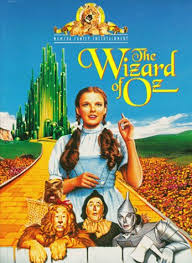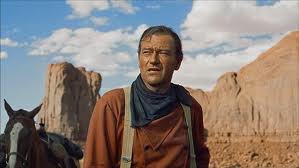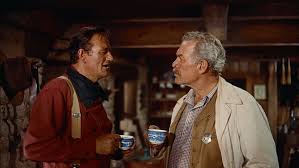Actors John Wayne, Natalie Wood, and Ward Bond starred in the 1956 film “The Searchers” where John Wayne is a personality actor in this film. Goodykoontz & Jacobs (2014) state “Personality actors are, at some level, playing themselves (or at least that is the perception). Films with strong personality actors can make it difficult for audiences to differentiate between the actor and the character.” John Wayne had a big personality and most of us saw him as the character in the roles he played. John Wayne played a rugged cowboy in many movies and was selected for this role because he was such a well-known Western actor.
John Wayne
John Wayne as Ethan Edwards returns to his brother’s home to find his brother Aaron Edwards and sister-in-law Martha dead inside their burned home. Wayne’s strong personality shines through this scene and Wayne has the audience believing he is Ethan Edwards or maybe that Ethan Edwards is John Wayne. I think that many people see John Wayne and his characters as one person because he played the same type of strong, rugged, Western cowboy in most of his films.
Natalie Wood
Natalie Wood is a star in this film and could even be categorized as a wild card because of the many different roles she played until her untimely death. She started out as a child star at the age of four and starred in “Miracle on 34th Street” at the age of eight. Goodykoontz & Jacobs (2014) reports “Stars are actors who are simply famous on screen and off, personalities so magnetic that we are interested not just in their movies, but in their personal lives as well.” Natalie Wood was definitely a star that the public loved and was interested in. The many different kinds of characters played by Natalie made her a wild card star. From her early child roles to her teenage roles in “West Side Story” and “Splendor in the Grass” and adult roles in “Cat on a Hot Tin Roof” and “From Here to Eternity”, she was an accomplished multi-talented actor. Natalie was selected for her role in “The Searchers” because of her acting ability as a young teenage actress who had been nominated for an Academy Award for Best Supporting Actress in “Rebel Without a Cause” the year before.
After ten years of searching for Debbie, Ethan finds Debbie and takes her home.
Ward Bond
While Ward Bond played in many different movies, including “It’s a Wonderful Life,” he starred in a lot of Western movies and was cast as a personality actor in “The Searchers.” He was also a rugged man and was cast in this film most likely because he had made 20 other films with John Wayne prior to filming “The Searchers.” Bond made a total of 23 films with John Wayne and was inducted into the Western Performers Hall of Fame at the National Cowboy & Western Heritage Museum in Oklahoma City.
Ward Bond is cast as the Reverend and Captain Samuel Clayton who gathers a group of settlers and deputizes them to go after the Indians who scattered the neighbor’s cattle.
Many actors find themselves trapped in a particular role that they cannot break from. Goodykoontz & Jacobs (2014) reiterates this by stating “Actors with distinctive personalities who manage to click with audiences often wind up playing similar characters in film after film.” Most of John Wayne’s movies were Westerns but he did make several war movies such as “Sands of Iwo Jima” and “The Longest Day” where he also played a strong personality. In “Sands of Iwo Jima” John Wayne plays a tough Marine Corps sergeant who puts his squad through rigid training to prepare them for the battlefield. Although Western movies are not as popular as they were in the 1930s through the 1950s, John Wayne would still be placed in strong and aggressive film roles today if he were making movies.
References
Goodykoontz, B., & Jacobs, C. P. (2014). Film: From watching to seeing (2nd ed.). San Diego, CA: Bridgepoint Education, Inc.
Google Images. It’s a Wonderful Life. Retrieved from It’s a Wonderful Life
Google Images. John Wayne. Retrieved from John Wayne
Google Images. Rebel Without a Cause. Retrieved from Rebel Without a Cause
Google Images. Sands of Iwo Jima. Retrieved from Sands of Iwo Jima
Google Images. The Alamo. Retrieved from The Alamo
Google Images. The Searchers. Retrieved from The Searchers
You tube. Sands of Iwo Jima (1949) – John Wayne. Retrieved from https://www.youtube.com/watch?v=dRNoESz337o
You tube. The Searchers: John Wayne returns to his family’s homestead. Retrieved from https://www.youtube.com/watch?v=30N-weocZT4
You tube. The Searchers: Let’s go home Debbie. Retrieved from https://www.youtube.com/watch?v=ci3a4zc-40I
You tube. Ward Bond in John Ford’s “The Searchers”. Retrieved from https://www.youtube.com/watch?v=zn-0LOPnQNw













